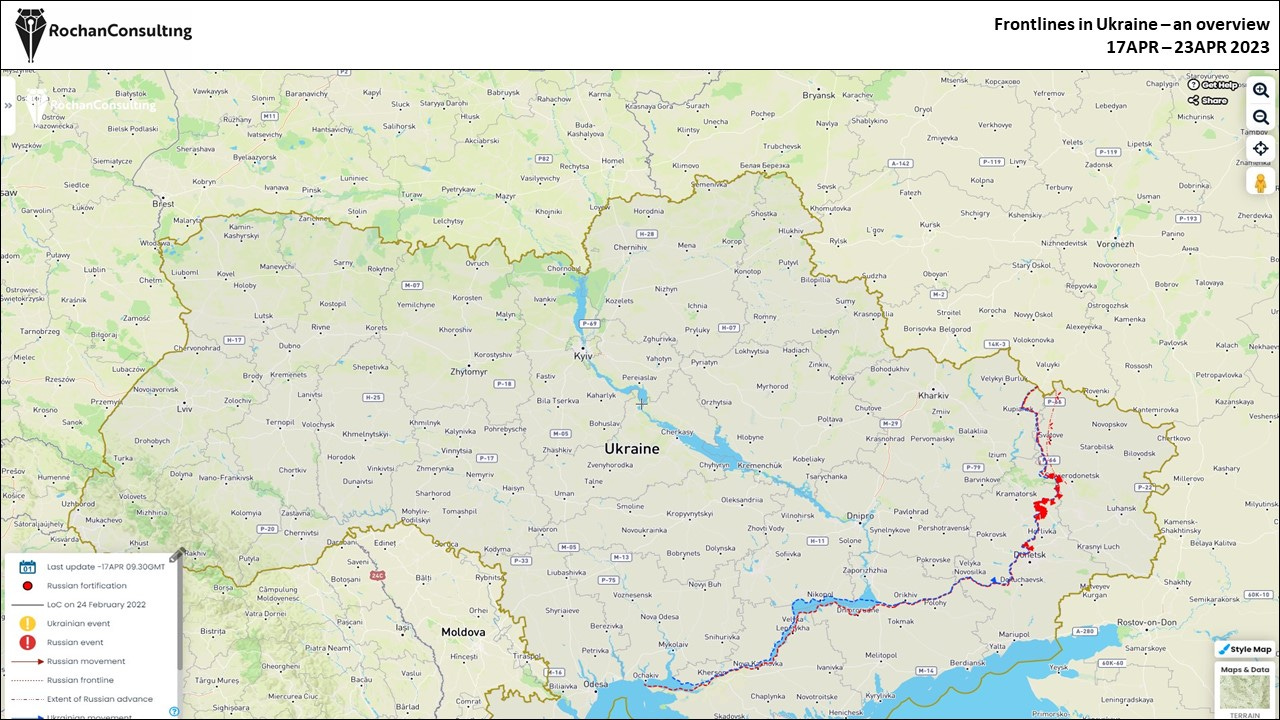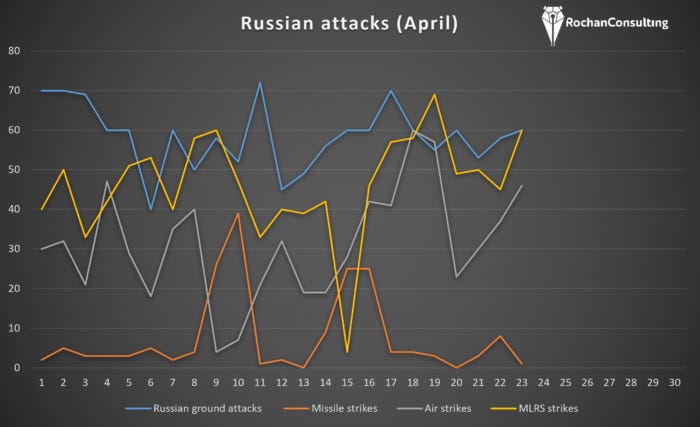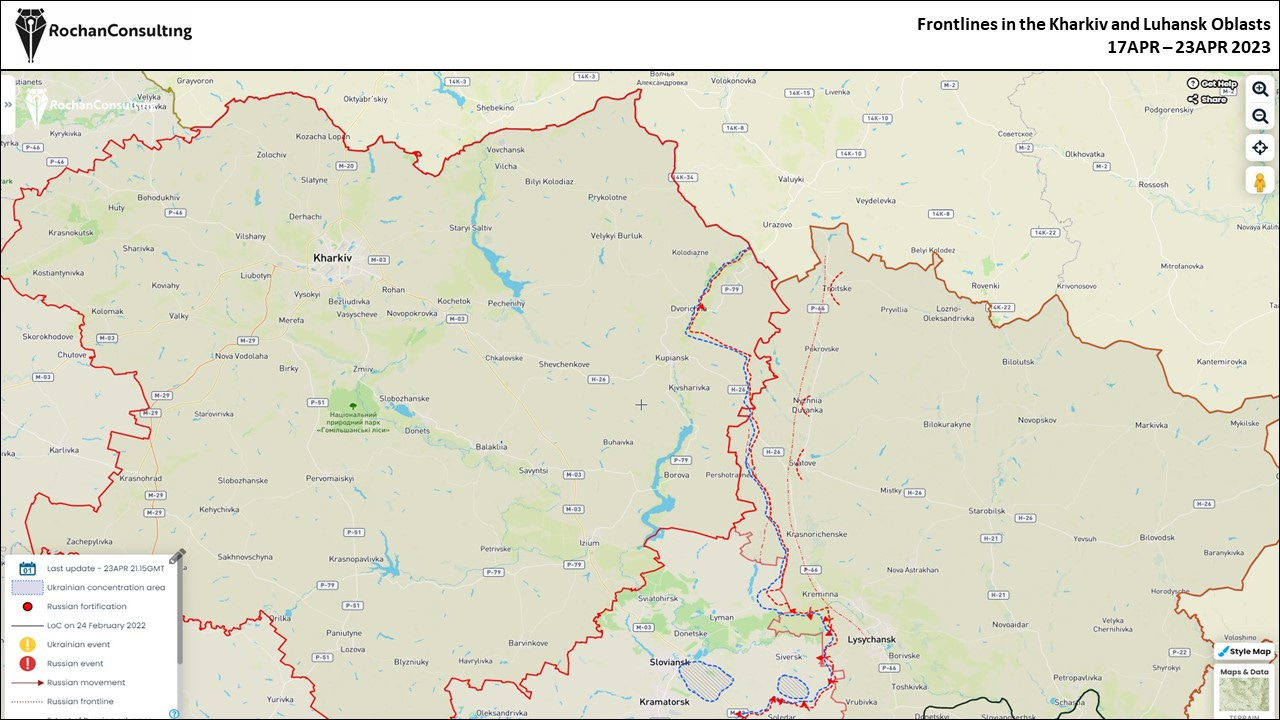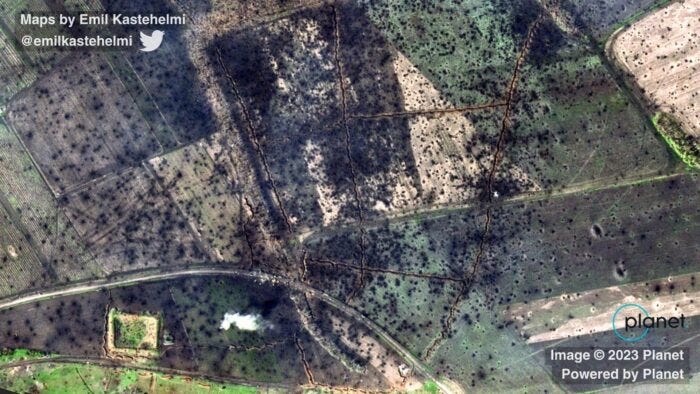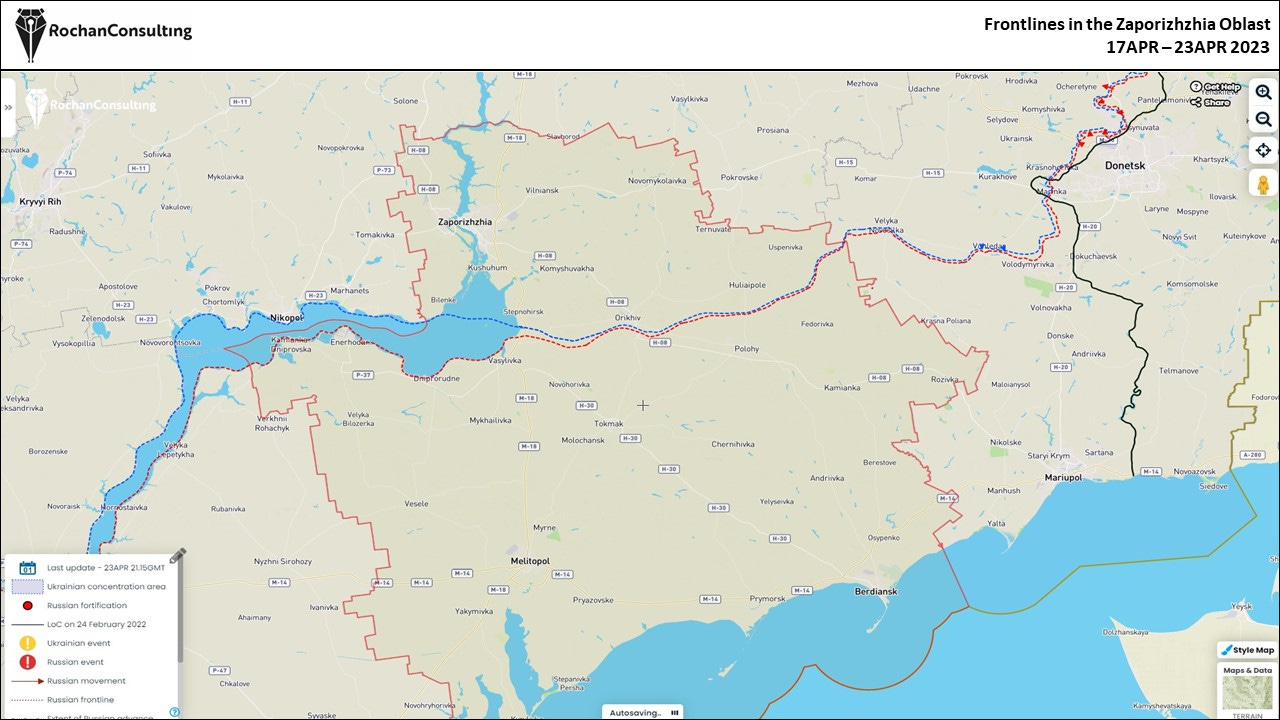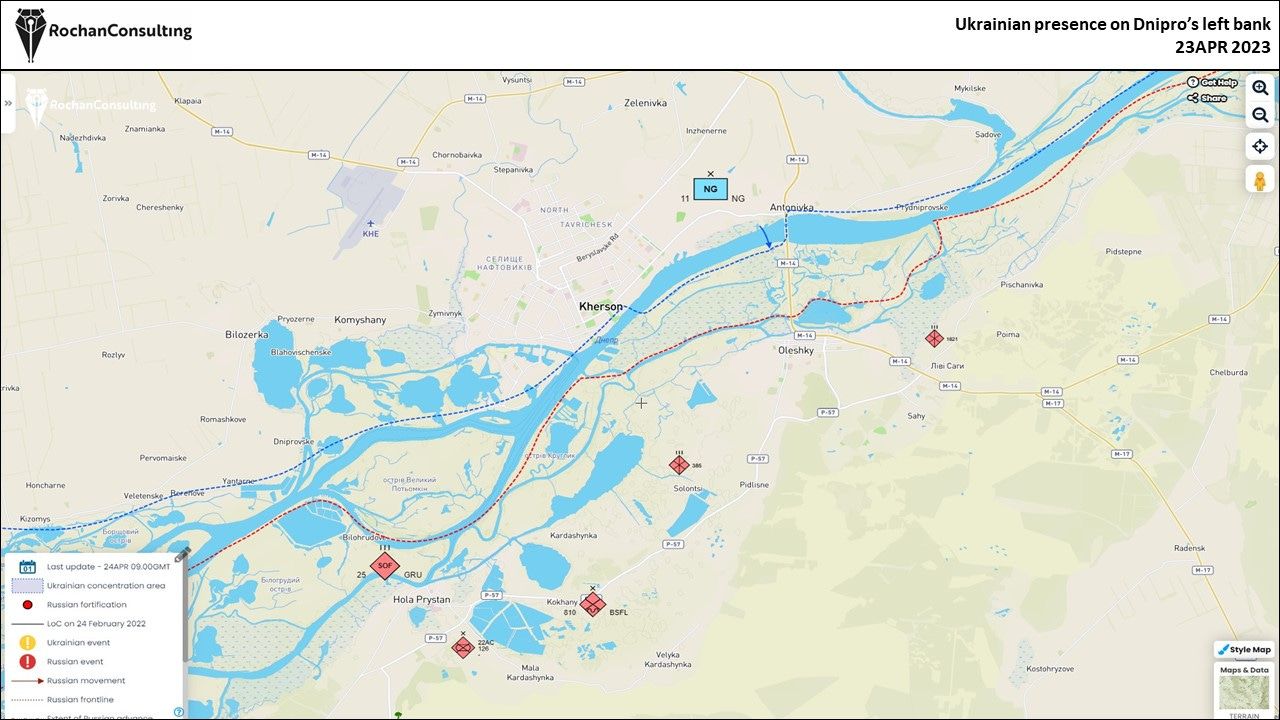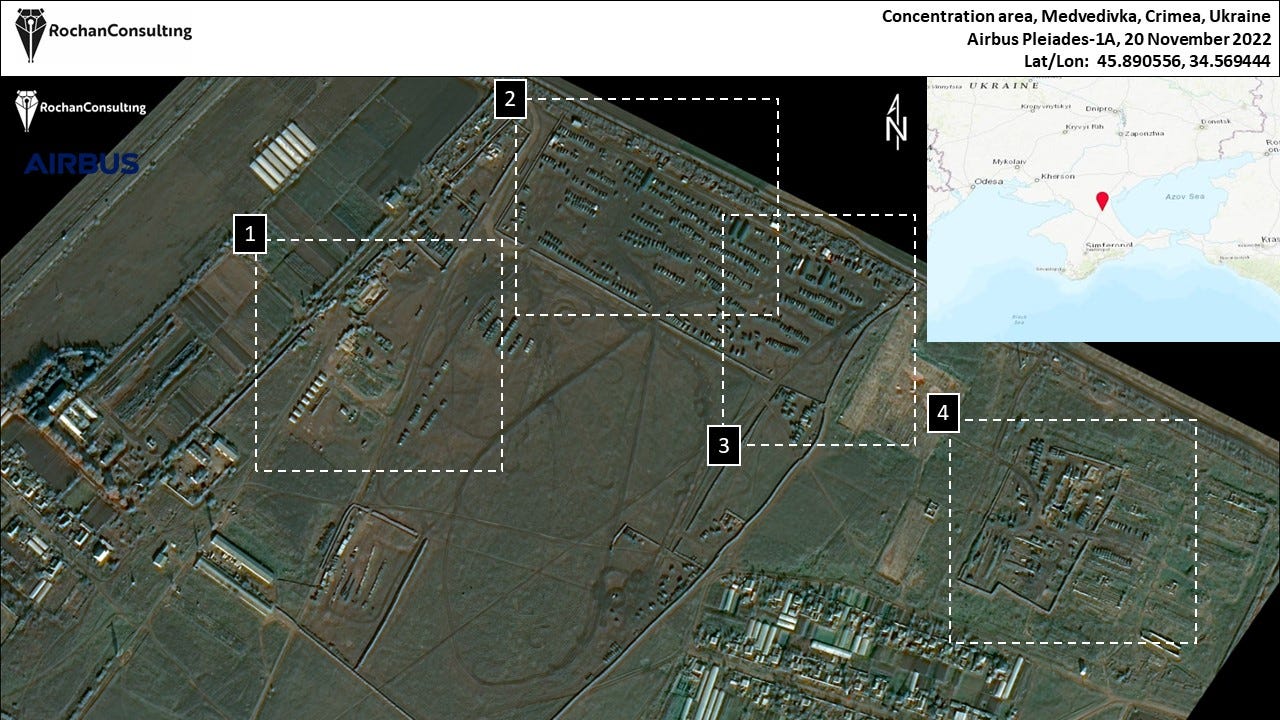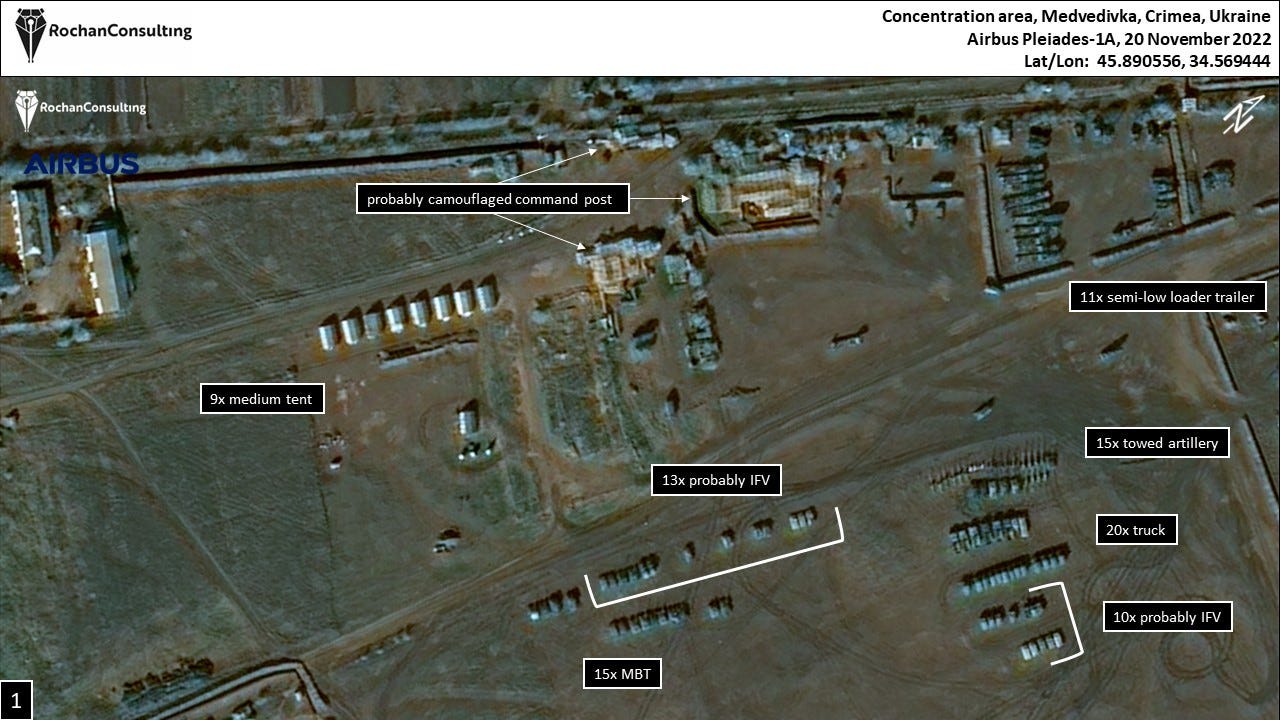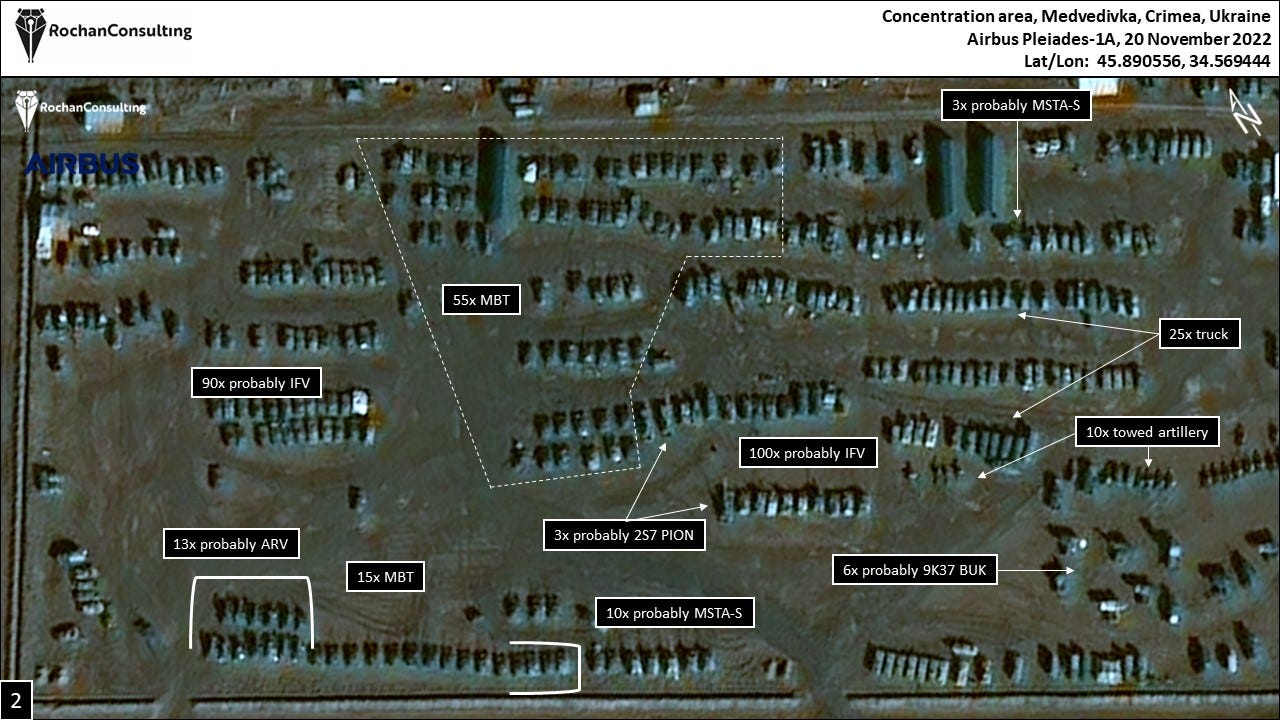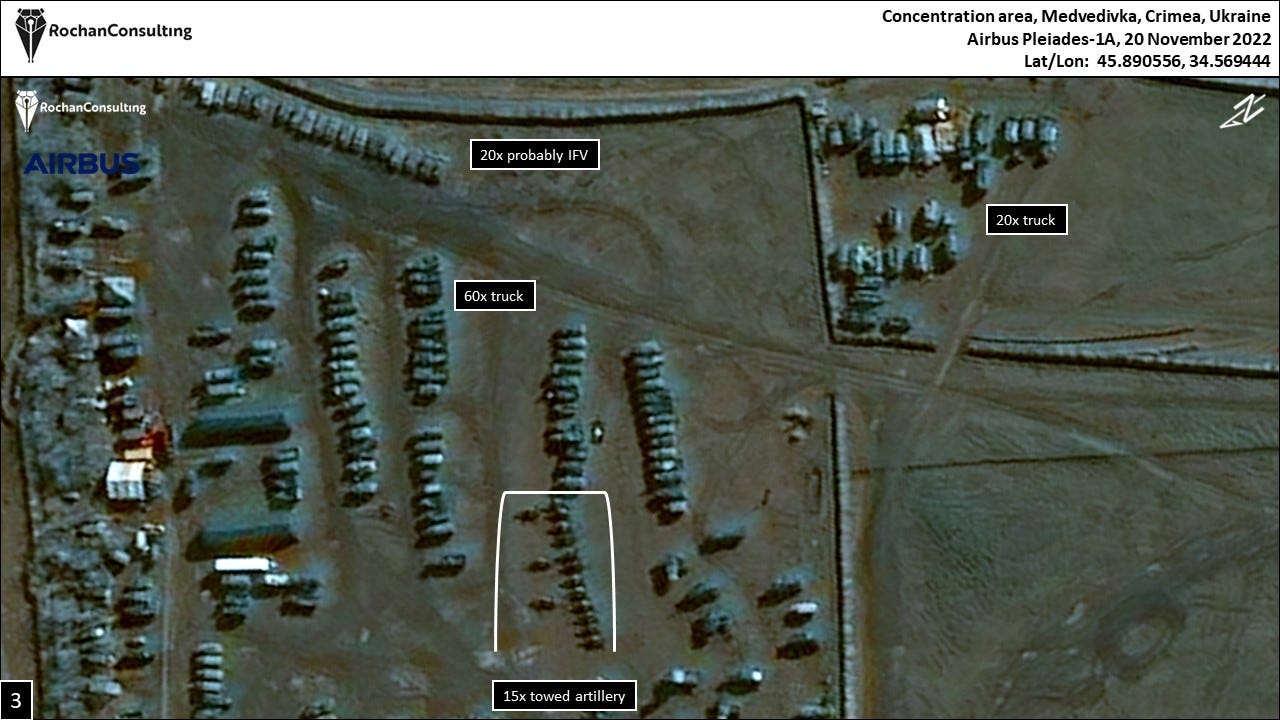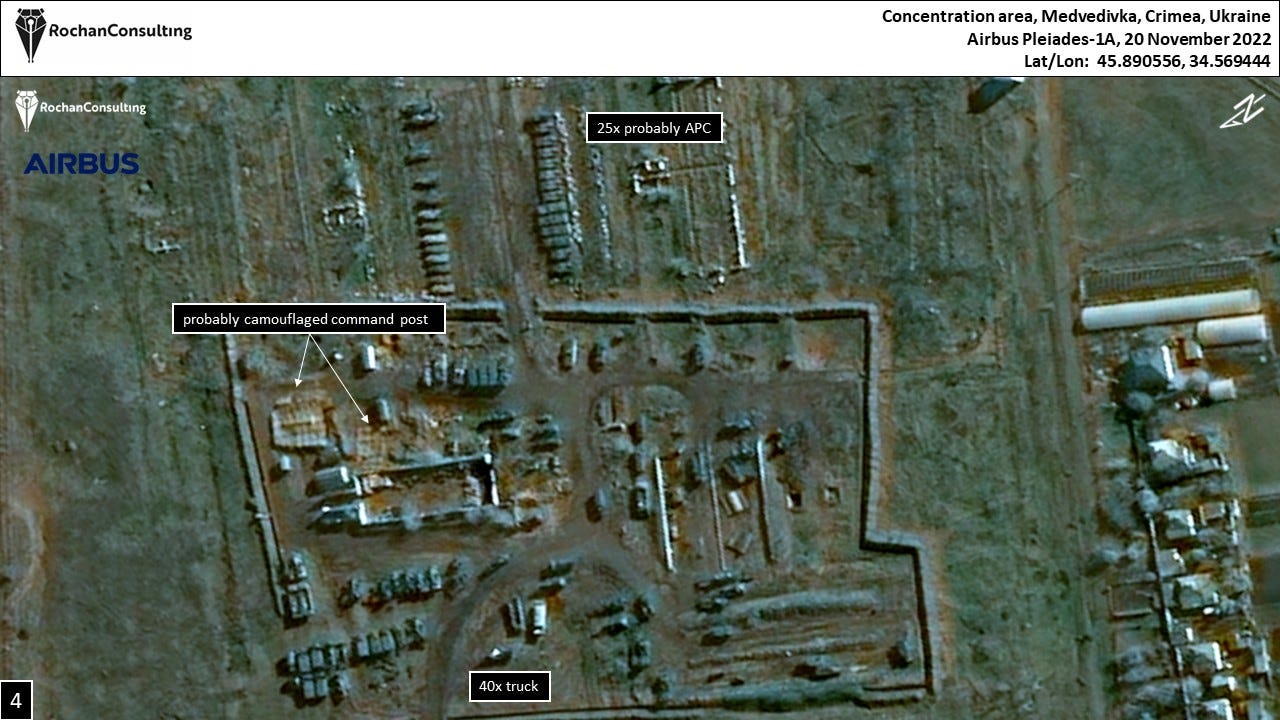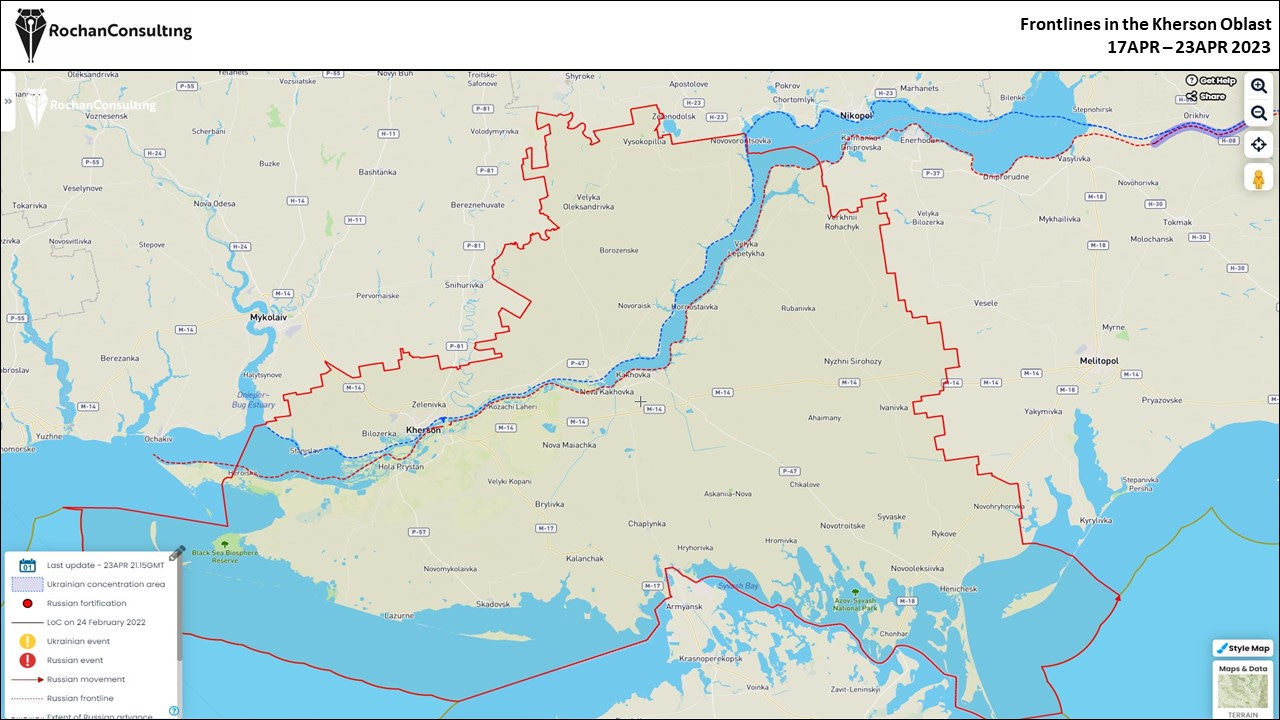Ukraine Conflict Monitor - 17 April – 23 April 2023 (Weekly update)
Situational report 17 April – 23 April 2023
Key takeaways from last week’s developments:
Last week did not deliver any major changes in the ongoing war in Ukraine; Russian attacks continued, but apart from the Bakhmut area, they made no territorial gains;
Russians slightly increased the geographical scope of their attacks in the Kharkiv Oblast, but their assaults did not alter the frontline in the region;
Previous reports about Russian gains near Makiivka in the Luhansk Oblast proved to be unfounded; The attackers made no territorial gains in the oblast, despite concentrating a sizable force, especially in the Kreminna area;
For another week, Russians made no confirmed gains in the broader Donetsk Oblast; Their offensive potential near Advdiivka petered out, while attacks in other seemingly prioritised areas (Mariinka and Pervomaiske) were pushed back.
Russians extended their gains in Bakhmut, where they now control more than 70 per cent of the city; Last week, Wagner also captured some territory very close to the road linking Bakhmut with Chasiv Yar, severing it physically at some point. Although Russians were pushed back, future assaults in this area are likely;
The situation in the Zaporizhihia Oblast remained unchanged; However, Russian sources claimed that Ukrainians deployed new units into the region, presumably to take part in the upcoming offensive;
Ukrainians reportedly established a limited military presence on Dnipro’s left bank in the Kherson Oblast; Much information about this development remains vague, but it appears that Ukrainian diversionary forces captured some territory; At the current stage, it does not appear that this is a bridgehead to be further expanded;
The Belarusian Armed Forces continued the readiness check, although the number of exercises decreased compared to the previous week; At least 1,000 soldiers conscripted to the armed forces last year left the service last week; The spring intake will see new 10,000 men drafted, which is in line with previous year’s figures;
*The weather forecast section has been moved to the bottom of the page*
General outlook
The war continued to be in the transitory phase, where both sides were preparing for the upcoming Ukrainian counteroffensive. Despite continuous Russian attacks, the frontline did not shift again last week. The only exception was the Bakhmut area, where Russians progressed within the city and its outskirts. Near Khromove, they threatened the Ukrainian presence near the key road linking Bakhmut with Chasiv Yar.
On Sunday (23APR), Ukrainian media reported about the visit of Ukrainian Ground Forces commander Colonel-General Alexander Syrsky to Bakhmut. Thus, the trip confirms Kyiv’s intention to hinder the Wagner advances for as long as possible. Indeed, on Sunday, President Zelensky said that “it is impossible for us to give up on Bakhmut because this would [help] expand the battlefront and give the Russian forces and Wagner a chance to seize more of our lands.”
Currently, Ukrainians control around 27 per cent of the city. Russian artillery strikes on Ukrainian positions have also seemingly intensified, but this could stem from the fire pocket becoming smaller and, thus, easier to hit. According to our sources, the ratio of losses in Bakhmut is now 1:1 at best, but 2:1 (Ukrainian vs Russian) is more realistic.
Russian sources also voiced much concern last week about the situation in the Zaporizhihia Oblast and the reported deployment of additional Ukrainian units into the region. They considered these shifts to be preparations for the upcoming counteroffensive. Besides the ongoing work on fortifications in southern Ukraine, Russians have also been preserving their missile stocks. The last large-scale missile strike occurred on 9MAR when 81 missiles and rockets were fired on Ukraine. Until then, Moscow conducted such strikes every fortnight as well. However, since mid-March, Russian strikes were mainly limited to kamikaze drones and S-300 missiles, and no large-scale employment of cruise or ballistic missiles was recorded. Undoubtedly, once Ukrainians start moving, the fire intensity from both sides will be very high.
Nevertheless, Ukrainians are confident that the offensive will be successful. The head of Ukrainian Military Intelligence, Kyrylo Budanov, claimed it was possible that all territory captured by Russia post-2014 would be liberated this year. Interestingly, he added that he did not expect Russians to conduct a nuclear strike if the frontline shifts to Crimea. Based on the conversations we have heard with our sources, Budanov is not the only one who believes that a return to the post-1991 border is possible. But, currently, it is difficult to assess their capacity to conduct and sustain such an operation across different directions.
Last week, Ukrainians probably continued PSYOPS against Russians deployed in southern Ukraine. There were reports about alleged calls for evacuation of Tokmak citizens. A Ukrainian operation establishing some presence on the Dnipro’s left bank near Kherson could also be considered a diversionary attempt to force Russians to shift their forces from other areas. What is clear is that Ukrainian informational operations seeking to influence Russian decision-making processes will continue to increase. We are certain that Ukrainians are only starting with their battle-shaping efforts.
Summary of losses
According to the Russian Ministry of Defence, since the start of the war, Ukraine has lost 411 aircraft (+4), 228 helicopters (0), 3,834 UAVs (+36), 415 anti-aircraft missile systems (launchers?)(0), 8,809 tanks and other armoured combat vehicles (+120), 1,093 MLRS launchers (+7), 4,647 field artillery guns and mortars (+42), as well as 9,721 units of special military vehicles (+157).
According to the Ukrainian General Staff, Russia lost (eliminated) 186,420 personnel (+4,170), 3,675 tanks (+18), 7,131 armoured combat vehicles (+48), 2,837 artillery systems (+42) and 539 MLR systems (+1), 289 anti-aircraft systems (+5), 308 aircraft (0) and 294 helicopters (+1), and 2,402 UAVs (+63), 5,730 vehicles and fuel tanks (+72), 911 cruise missiles (0), 18 warships and boats (0) and 339 special vehicles (+13).
(Numbers in parentheses denote a weekly change)
Military situation in Belarus
Last week did not bring new developments regarding the military situation in Belarus. The military-political leadership and the Belarusian Armed Forces presented moderate activity. The training load of the military formations decreased what was likely correlated with the completion of military service by the last year’s conscripts.
Regarding the political sphere, two events were noteworthy. On Tuesday, Belarusian President Alexander Lukashenko met with the Head of the Donetsk People’s Republic, Denis Pushilin. Despite a lack of information in official statements, it seems that leaders discussed the issues of Belarusian support to the region. During the meeting, Lukashenko expressed his readiness to help residents suffering from the war and asked Pushilin about the best ways to achieve this ambition.
At the same time, the Belarusian Deputies ratified the agreement regulating military-technical cooperation between Belarus and Russia. The act regulates the joint approach to the deliveries of military equipment, the organisation of scientific research and the creation and modernisation of weapons, equipment and other special-purpose products until 2025.
Over the past seven days, some Belarusian officers participated in several international events.
On Wednesday, the First Deputy Head of the International Military Cooperation Department, Col. Alexander Vengura, took part in two accreditation meetings with foreign military diplomats. The first one involved Indonesian Defence Attache (Col. Budi Susilo), Military Attache (Col. Edi Suokhmat Setia Tuho Bagio) and Naval Attache (1st Rank Capt. Febri Jacob Paruntu) who exchanged views on the issues of bilateral military cooperation and the participation of Indonesian delegation in the upcoming MILEX-2023 military exhibition. During the second one, Vengura met with the new Malesian Defence Attache, Col. Sebastian Arokiyaraj William, the first military diplomat from Malesia accredited in Belarus.
Two days later, the Chief of Belarusian General Staff, Maj. Gen. Viktor Gulevich led the Belarusian delegation during the Collective Security Treaty Organisation (CSTO) Military Committee meeting. During a videoconference, Gulevich presented the organisation’s priorities for 2023 (Belarus holds chairmanships this year). He also discussed challenges and threats to military security in the organisation’s area of responsibility and the implementation of joint training measures.
Subsequently, the Belarusian delegation also participated in the working meeting of the CSTO Medical Services representatives. This event was held at the Belarusian Central Officers House, where CSTO representatives discussed a joint approach to medical support and the future development of the medical support system. According to the CSTO Medical Service head, Col. Ivan Pchelnikov, all developed solutions will be implemented in the draft decision “Recommendations on medical support collective CSTO forces”.
Regarding Belarusian military leaders’ “domestic” actions, 12 officers, including one woman, were promoted to the Colonel rank on Friday.
On Tuesday, the Secretary of the State Security Council, Lt. Gen. Alexander Volfovich, took part in the opening ceremony of the XXIX International Forum on Information and Communication Technologies TIBO-2023, where he spoke about the role of digital sovereignty in the modern world. During his speech, Volfovich stressed that the state and public institutions, as well as business entities, should work in a coordinated way to protect digital sovereignty. He added that digitalisation is actively growing within the economy, but also in education, healthcare and national security, and because of that, it should be implemented reasonably.
Volfovich claimed that countries had used the destructive powers of the Internet to influence Belarusian society. As a result, developing an effective cybersecurity system is now more relevant than ever and necessary if Belarus wants to protect itself effectively.
Last week, the Belarusian MoD published initial information about the upcoming start of the spring conscription. Military units will start the induction of citizens from 26 APR. Initially, the Belarusian Special Operation Forces, the 72nd Joint Training Center, and the Minsk Commandant’s Office will take in about 1,000 out of the 10,000 to be drafted this spring.
Last week, most Belarusian military formations held farewell ceremonies for conscripts finishing their military. Such events occurred in:
6th Mechanised Brigade (Monday);
557th Engineering Brigade (Monday);
36th Road and Bridge Brigade (Monday);
120th Mechanised Brigade (Thursday);
111th Artillery Brigade and 48th Electronic Warfare Battalion (Thursday);
103rd Airborne Brigade (Thursday);
5th Spetsnaz Brigade (Thursday);
72nd Joint Training Center (Friday);
56th Communications Regiment (Friday);
15th Air Defence Brigade (Friday);
465th Missile Brigade (Friday);
310th Artillery Group (Friday);
38th Air Assault Brigade (Friday);
50th Mixed Aviation Base (Friday);
61st Fighter Aviation Base (Friday);
48th Radiotechnical Brigade (Saturday);
51st Artillery Brigade (Saturday);
Altogether, around 1,000 men were dismissed.
In other news, the Belarusian MoD also ordered 2,400 first aid kits for BYN880.000 (approximately 300,000 USD). We currently do not link this purchase to any particular development. If Minsk was planning to join the war, the number of kits on order should undoubtedly be higher.
Last week, the 11th Mechanised Brigade and Special Purpose Detachment of the 432nd Main Military Clinical Medical Center continued participation in the ongoing combat readiness check of the Belarusian Armed Forces.
According to the Deputy Commander of the Western Operational Command (OC), Col. Dmitry Bitny, reservists involved in the drills restored their skills quickly and passed various stages of combat coordination. They are now actively preparing to participate in the (brigade-level) tactical exercise based on the lessons learnt from the ongoing Russo-Ukrainian war. On Saturday, Bitny pointed out that the high motivation among Belarusian service members resulted from various measures – the deployment of field kitchens and baths and the constant surveys linked to their needs.
Unofficial sources claimed that a Belarusian reservist died during an exercise on Tuesday. However, this information has not been independently verified. Official sources did not confirm the story.
The Territorial Defence Forces of the Novogrudok and Korelichsky regions (Tuesday-Thursday), as well as the 19th Mechanised Brigade (Wednesday-Thursday) and 8th CBRN Brigade (Thursday-?), underwent independent command-staff exercises.
On Wednesday, the 15th Air Defence Brigade started its tactical exercise. During its course, the S-300 battalion, accompanied by the Tor-M2K subunit (responsible for protecting the convoy on the move), departed to the destinated area to perform combat duty tasks.
Subsequently, 4th-year cadets of the Belarusian Military Academy (Air Defence Faculty) performed firing exercises (involving Osa anti-air system and Igla MANPADS) at the 174th Air Force and Air Defence Forces Training Ground. At the same time, the 227th Combined Arms Training Ground hosted the state tests of the T-72BM2 tank related to the protection level.
A day later, about 200 servicemen of the 5th Spetsnaz Brigade participated in the parachute jumps from Mi-8 helicopter(s).
Over the past seven days, ground transfers involving Belarusian military equipment were relatively regular. Some specialised systems like the R-414MBRP radio station or PKT-2 track-laying vehicles were on the move, likely linked to the ongoing military drills.
Notably, unofficial sources reported the movements of three military echelons on Friday.
The first one included equipment of the 120th Mechanised Brigade (more than 20 BMP-2, three MT-LBs, P-240 radio station and BTS-4 tractor) observed at Ashmyany Railway Station, while the second consisted of at least two 2S1 batteries of the 191st Artillery Group that were seen at Orsha-Vostochnaya Railway Station. The third one spotted on the move in Minsk included at least ten 2S1 SPHs and a few 1V13/1V14 vehicles of the 310th Artillery Group.
Last week, at least five Russian transport aircraft arrived in Belarus:
An-12 (RF-08624) – Monday;
An-26 (RF-36126) – Monday;
Tu-134 (RA-65992) – Monday;
An-124 (RA-82013) – Tuesday;
An-26: (RF-36009) – Friday;
Moreover, Russian Mi-8 helicopter(s) deployed at Machulischy Air Base carried out at least six training flights, mainly spotted near training grounds where Russian servicemen trained. The situation on the ground remained unchanged. Nonetheless, dozens of Russian trucks were observed on Thursday and Saturday. Also, on Thursday, unofficial sources informed about the presence of 50 Russian Airborne Troops (VDV) soldiers at Minsk-Passenger Railway Station.
Please click here to access the summary of Belarusian training activities since 1JAN.
The situation at selected axes and directions
Kharkiv direction
The operational situation did not change last week in the Kharkiv Oblast. No reports surfaced suggesting shifts in the frontline. A minor change we observed pertained to the number of settlements Russians attacked. Prior to last week, Russian units typically assaulted Hrayanykivka, Masiutivka and Krohmalne. Last week, however, they extended these attacks to Synkivka. Although we are not sure what caused the attackers to include Synkivka in the list of their targets (apart from the proximity to Kupyansk), we are almost certain that this change does not herald any significant changes in the region.
Russians did not conduct any ground attacks from Russia proper onto the Kharkiv Oblast. But they remained committed to undertaking border air, missile and artillery attacks. These strikes hit many villages and cities, especially across the northern parts of the Oblast. Based on official statements, these strikes mostly hit civilian areas, especially as they are conducted using missiles fired from the S-300 air defence system.
On Friday, the Russian MoD confirmed that one of its bombs was accidentally dropped by an S-34 onto Belgorod. We understand that the bomb was the FAB-500 (500-kilogram (1,100 lb) general-purpose air-dropped bomb with a high-explosive warhead). As the reader is probably aware, for the past few weeks, Russians have been using glide kits on their bombs to extend their reach and increase the survivability of their combat aircraft as they do not need to enter zones where Ukrainian air defence systems operate. With Kharkiv being less than 70 km (43 miles) away from Belgord and within the FAB-500 glide-kit improved range, we assume the kit did not deploy properly, and the bomb just dropped. On Saturday, news broke that another bomb was found near where the first landed. Two bombs not deploying their kits on a single bombing run is unusual, but so far, we have seen no evidence to indicate that the Russian air force suffers from chronic technical issues pertaining to the use of glide bombs.
Luhansk direction
The overall situation in the Luhansk Oblast did not change. Two weeks ago, Ukrainian sources claimed that the Kreminna-Lyman direction was the heaviest-shelled region in Ukraine. Last week, no such reports were made. At the same time, no data was provided about the scale of the artillery strikes and Russian losses, so it is difficult to assess whether Russians increased or decreased the tempo of their attacks in the region.
Regardless, Russian attacks, decreased or increased, brought only reported and small frontline changes. Russians made no confirmed gains.
Again, most of the fighting occurred between Ploshchanka – Bilohorivka, while the northern part of the region remained relatively calm.
Last week, we mainly focused on the situation near Makiivka, where Russians reportedly progressed two weeks ago. However, no confirmation of Russian advances was published, either from the Russian or Ukrainian side. We thus assess that the Russian progress near Makiivka was either short-lived or did not occur at all.
Apart from that, there were five other noteworthy events/developments.
Firstly, a Russian journalist/propagandist claimed that a meeting engagement (встречный бой) occurred in the Kolomyychikha area. Meeting engagement is “a combat action that occurs when a moving force engages an enemy at an unexpected time and place”, usually in “small unit operations”. This characterisation of the skirmish near Kolomyychikha highlights ISR’s weaknesses on both sides. The source also did not provide any additional information about the engagement, so it is unclear what losses either side incurred.
Secondly, battles continued in the Serebryansky forest and near Dibrova in the Kreminna area. Ukrainian sources claimed last week that many Russian forces in this sector came from the 90th Tank Division, the 144th Motor Rifle Division, and several BARS (army combat reserve) units. But, despite such a concentration of armour, Russians made no progress in the area for weeks, and nothing suggests that the situation could change.
On Thursday, Russians reportedly advanced in the forest area near Shypylivka. The source failed to provide any further information regarding this progress. Another Ukrainian source claimed that, on 19APR, Ukrainian troops advanced east of Kuzmyne (here and here). The source added that it was not clear whether the UAF had managed to gain a permanent foothold in this area, but the progress was noteworthy. Over several days, Russians reportedly lost three tanks in this direction: two modernised T-72s (T-72B3s?) and a T-90 Proryv in the Kreminna sector.
On Wednesday, the Ukrainian General Staff reported that Russian authorities received an order to deploy a 40-bed military hospital in Kabychivka in the Luhansk Oblast and that an unspecified number of Russian doctors are expected to arrive at the hospital by the end of the past week. We have looked at satellite imagery and saw no military-type hospitals established in this area. If such a hospital exists, it is likely operating within the existing medical support infrastructure in the city.
Lastly, also on Wednesday, Russians launched no attacks towards Terny, Torske and Nevske, which was unusual. This lack of activity was either caused by regrouping/rotation or exhaustion of already limited offensive potential.
Donetsk Oblast Direction
Russians continued to advance in Bakhmut, while their attempts to alter the frontline in other parts of the Donetsk Oblast were unsuccessful last week. But, the past seven days showed that Wagner’s offensive potential was not yet exhausted and was still a combat effective force.
Let’s look at the frontline starting from the northern parts of the region. On Monday, a Russian source commented on Russian air operations. The source said that Russians had hit Ukraine’s “new defence line” near Slovyansk, Kramatorsk and Kostyantynivka with glide bombs. As stated above, Moscow’s intensified use of glide bombs to increase strike range is well documented. However, previously no attacks on Slovyansk or Kramatorsk using these capabilities were reported. But, we need to add that while future attacks on the two cities may be likely, we do not expect to see significant shifts in how Russians run their bombing campaigns. The focus is first and foremost placed on military targets, closer to the frontline rather than population centres.
Russians made no progress in areas north of Soledar. This pertains to Verkhnokamyanske and Vyimka, Vasiukivka, Fedorivka, Rozdolivka, and Vesele and Orikhovo – Vasylivka, Hryhorivka, Bohdanivka and Minkivka. However, interestingly, a Ukrainian source claimed early in the week that Ukrainian liberated some territory near Spirne. Thus far, the event has had no major overall repercussions from the operational point of view. We also did not consider this change a prelude to a larger Ukrainian attack on the area.
When it comes to Bakhmut, the overall situation deteriorated for Ukrainians last week. Particularly concerning events took place mid-week near Khromove. Wagner units allegedly dislodged Ukrainians from their positions near the 0506 road linking Bakhmut from Chasiv Yar. Russian success was, however, short-lived, as a Ukrainian counterattack pushed Russians back. Nevertheless, the event marked the first time the road was physically severed, bringing Russians closer to the encirclement of Ukrainian troops in Bakhmut. We are unsure whether the Russian attempt near the road resulted from regrouping at the cost of their attacks in Bakhmut or whether Russians had auxiliary forces available and decided to order them to take the road.
SSpeaking of this important road section, a Finnish analyst, Emil Kastehelmi, posted interesting satellite imagery showing various Ukrainian defensive measures to preserve their control over the road.
Moving onto Bakhmut, the State Border Guard Service of Ukraine claimed that Russians showed no signs of shell-hunger, which is consistent with our previous assessments. On Tuesday, the commander of the 127th Territorial Defence Brigade stated that Russians sent wave after wave of assault groups, but Ukrainians repelled all attacks. It also suggests that the attackers do not suffer from a manpower deficit.
Russians focused their attacks on Rose Alley, capturing several blocks of flats. Russian blogger claimed that the Wagner units pushed north along Levanevskoho, Oborony and Pobiedy Streets. The fighting also occurred from Levanevskoho Street to Tchaikovskoho Street to the south. According to a Ukrainian soldier deployed in the city on Wednesday, Ukrainian troops managed to liberate two streets in Bakhmut (the soldier did not name these streets, citing security measures). Still, on 20APR, he said Russians sized one of these streets back. By Saturday, all Ukrainian gains were reversed.
Battles for the rail station continued, but we understand they were inconclusive. Russians nevertheless tried to improve their positions southwest of the train station and captured Ukrainian strongholds in the eastern part of the Heologiv and Skovoroda lanes.
Jan Gagin, an adviser to the acting head of the Donetsk People’s Republic, claimed that the town was surrounded. Later, Yevgeny Prigozhin, the Wagner PMC head, denied this statement and said that Ukrainian troops were currently in a so-called operational encirclement where the roads to the city were under fire control. Prigozhin was correct. No physical encirclement has so far occurred, but the fact that Russians fire control all entrances to the city does not prevent Ukrainians from deploying new forces and equipment to Bakhmut.
Russians claim to control about 83-84 per cent of Bakhmut. We assess this number as around 73 per cent based on verified reports.
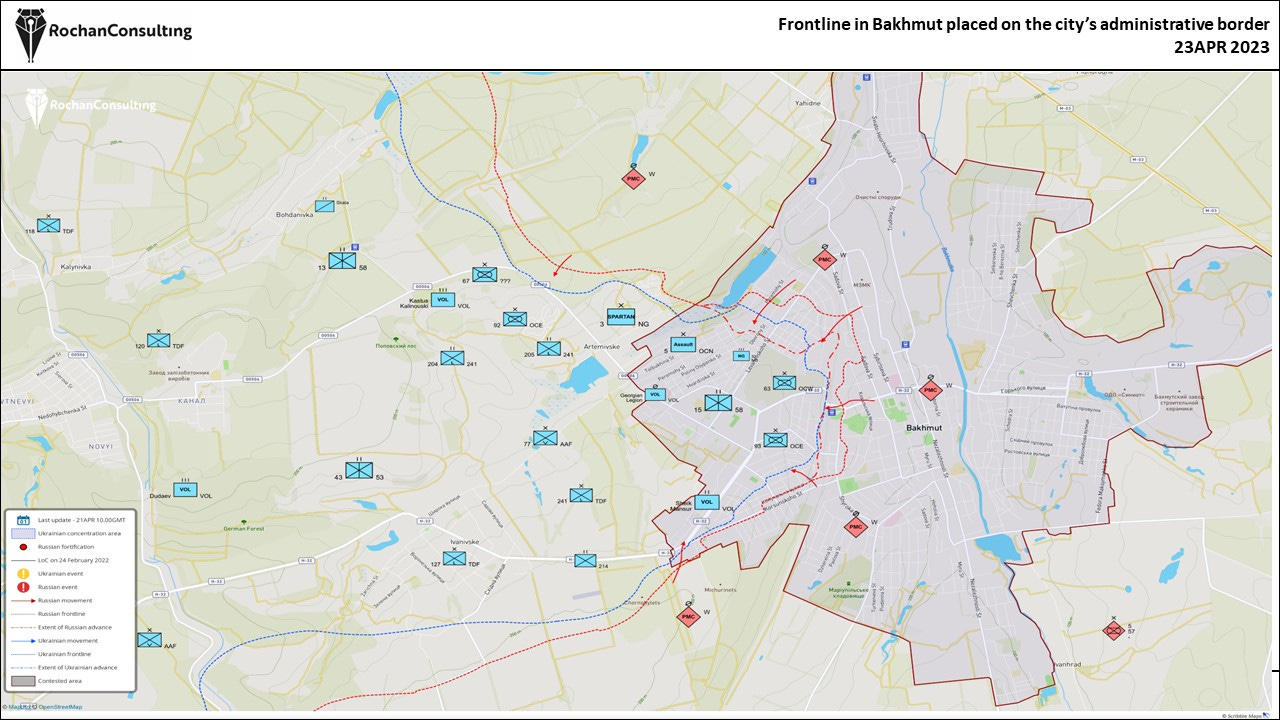
On the other hand, the southern flank of Ukrainian defences did not tumble last week. All Russian attacks along the Predtechyne – Ivanivske line were pushed back. We do not know to what extent Ukrainians use this road to support their presence in Bakhmut. A few weeks ago, Russians destroyed a bridge west of Ivanivske, but despite this, the terrain offers some ways around the bridge, so it is possible that the road could still be used.
Ukrainian successes in defending this sector could be attributed to their artillery attacks on Russian rear areas around Klishchiivka, which serves as a primary logistics hub for Russian units operating south of Bakhmut.
Last week delivered no changes in other parts of the oblast.
Russian troops reportedly attacked towards Stepove and Berdychi to gain control of the railway line there but were unsuccessful.
Russians reportedly tried to push forward near Keramik on several occasions but failed there too. There were also some attempts to alter the frontline near Novobakhmutivka, but all Russian attempts proved futile.
Neither Russian nor Ukrainian sources reported changes near Novokalynove, Berdychi, Stepove, Krasnohorivka, and Kamyanka.
Russian offensive potential near Avdiivka appears to be currently exhausted. Based on Russian and Ukrainian reports, all Russian attacks, which were small in size, were repelled. The attackers continued to use glide bombs in the area, but their utility on the battlefield is questionable when not used in conjunction with ground attacks. We expect no changes in how Russians conduct their operations and attacks. Therefore, we do not consider Avdiivka to be under threat of encirclement or being captured.
Russians also sustained their attacks on Pervomaiske and Severne but made no progress there.
Russians also tried to dislodge Ukrainians from the western parts of Mariinka and Pobieda. Attacks from the flanks, direct assaults, and continued air and artillery strikes delivered no results. The city is destroyed, and it does not appear likely that Russians will capture it without an encirclement.
Lastly, Vuhledar. A Russian source asserted on 17APR that Ukrainian troops attacked Russian positions south of Vuhledar. One sabotage group of the 72nd Mechanised Brigade conducted a reconnaissance-by-force attack near a forest belt north of Mykilske. Another light armoured assault force ( a platoon) from the 3rd Battalion of the 68th Jager Brigade attacked Russian military positions near Pavlivka. A combined Russian infantry and aviation effort of infantry units repelled both Ukrainian attacks. The source added that the 68th Jager Brigade was being reconstituted near Novoukrainka. A large number of men and equipment are concentrated in Bahatyr.
A Russian source speculated that one of the Ukrainian axes of attack could aim at Volnovakha to cut off the H20 highway linking Donetsk with Mariupol. The sources believed such a scenario would significantly complicate Russian logistics, fighting to defend against the UAF main attack towards Mariupol – Berdyansk area.
Russian attacks near Prechystivka and Pavlivka were unsuccessful.
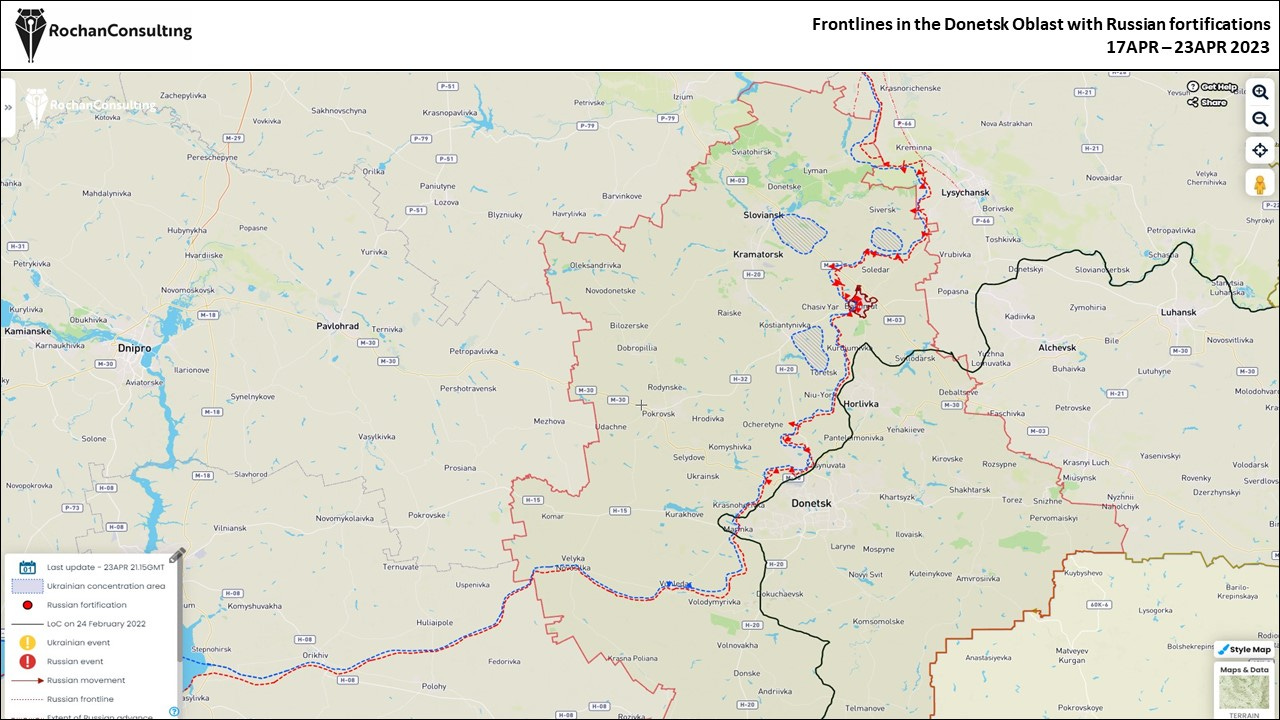
Zaporizhzhia direction
There were no changes to the frontline in the Zaporizhihia Oblast last week. Based on open-source reports, Russians conducted no attacks in the region. On the other hand, Ukrainians reportedly assaulted Russian positions in the Orikhiv area, which were repelled by the Russian 291st Motor Rifle Regiment (42nd Motor Rifle Division of the 58th Combined Arms Army, Southern Military District).
However, what particularly stood up from last week’s reports were concerns about the upcoming Ukrainian offensive in the region.
Firstly, on Friday, Alexander Gordeev, a Russian Eastern Group of Forces Spokesperson, claimed that a Russian-operated TOS-1A heavy flamethrower system was used to engage a Ukrainian stronghold near Novodanylivka. This statement confirms that Russians operate TOS-1 near the frontline and that it can be used to impede the movement of Ukrainian troops. On the other hand, with 6 kilometres (3.7 miles) range, deploying such a high-value asset near the frontline during opposing forces’ fast-paced attack carries big risks of the system being destroyed or captured.
Secondly, a Russian source provided information about the number of Ukrainian units deployed to the Zaporizhihia region. The source stated that elements of the Ukrainian 71st Jaeger Brigade had recently arrived to augment the second line of defence north of Huliaipole. In addition, Ukraine’s 46th Airmobile Brigade was reconstituted and deployed from the Soledar area towards Huliaipole. The source asserted that the command of the Zaporizhzhia group of forces regularly conducts communication checks with the 65th Mechanised Brigade, 71st Jaeger Brigade, 1st Tank Brigade, 102nd, 108th, and 110th Territorial Defence, the 46th Airmobile Brigade, and the 128th Mountain Assault Brigade.
This report came in addition to accounts highlighting an intensified number of Ukrainian attacks near the frontline. Russian troops are reportedly regrouping to prepare for Ukrainian ground attacks.
Also last week, the Head of the Zaporizhzhia Oblast Occupation Administration, Yevgeny Balitsky, announced that following a meeting with Cossack representatives, it was decided to create a Cossack army in the region. Its primary purpose will be to defend the Zaporizhihia Oblast from Ukrainian forces. It is unclear how strong the formation will be, but it is unlikely to be a game-changing force that will provide sustainable effort to the overall defensive effort.
Although we cannot be fully confident of this assessment, we believe that Ukrainians conducted two psychological or informational operations last week. Firstly, Ivan Fedorov, the Ukrainian mayor of Melitopol, stated that between Tokmak and Vasylivka, Russians drive around with loudspeakers urging residents to evacuate to Russia. Secondly, a Ukrainian journalist published a video which reportedly showed residents of Tokmak leaving the city due to intense hostilities. We have seen no indications to suggest that any hostilities occurred in Tomak, let alone ground attacks. The frontline is located some 30 km north of the city. We are unaware of any increases in Ukrainian artillery strikes in this sector. It is unlikely that Ukrainians diverted high-value artillery pieces (Krab, Pz2000, etc.) to target Tomak, especially because high-value targets are closer to the frontline.
Therefore, we consider such claims to be Ukrainian efforts to degrade the Russian will to fight, cause a sense of distrust in the Russian military leadership, and create confusion within Russian ranks.
Kherson direction and Crimea
Last week, Ukrainian forces reportedly established a military (probably temporary) presence on Dnipro’s left bank near the Antonovsky Bridge. The terrain where Ukrainians are located is marshy and swampy, thus unlikely to sustain any larger presence. But even if it did, Ukrainian positions would suffer from concentrated Russian artillery strikes without expanding their territorial control over the southern bank. We also cannot exclude a scenario whereby this operation is a diversion seeking to force Russians to redeploy units from other areas. Based on the few reports that surfaced, we assess that the Ukrainian presence on the Dnipro’s left bank is not a bridgehead that Ukrainians are currently actively trying to expand for further attacks deeper inland.
Apart from that, we need to note, based on Russian and Ukrainian reports, the number of infiltration and reconnaissance operations over Dnipro decreased over the past few weeks.
Related to riverine operations, although it reportedly happened in the Zaporizhihia Oblast, a Russian Lancet loitering munition hit what appeared to be a Project 376 Yaroslavets harbour boat. Russians thus undoubtedly run surveillance of the Dnipro to detect any changes in Ukrainian posture.
Indeed, last week, the Kherson Oblast occupation head Volodymyr Saldo claimed that Ukrainian units were preparing for a river crossing operation across Dnipro. To this end, they had been concentrating personnel and equipment on the river’s right bank. He did not specify where precisely, but undoubtedly concerns about a possible assault over the river are currently running high on the Russian and occupational side.
Russian forces prepare for the deterioration of the security situation in the region in three ways. Firstly, they continued expanding their echeloned defensive lines to hinder the movement of advancing Ukrainian units. However, in this respect, and based on data collected by Brady Africk, the Zaporizhihia Oblast is more prioritised compared to the Kherson and Luhansk Oblast. The focus on the former shows that Moscow is predominantly concerned about maintaining their lines in the Zaporizhihia Oblast (land bridge to Crimea) and considers an attack in this direction the most likely.
Ukrainians also claimed that Russians were preparing for a withdrawal, which is confirmed by the fact that they had packed up looted property and sent it away. We are not attaching particular importance to this development. While it likely confirms that Russians expect a pullback, it certainly does not indicate a total withdrawal from the Kherson Oblast.
Secondly, Russians have requisitioned civilian property for military needs. Although this announcement pertained to boats and other civilian vessels that the military could need, we assume that all civilian properties (cars, houses, etc.) have already been seized without proper legislation and are used to meet occupational forces’ needs. Last week, Russians detained 30 private vessels just from the port city of Henichesk. Occupational authorities claim that owners can ask for compensation.
Lastly, Brady also published satellite images showing Russian forces continuing to use a base near Henicheska Hirka, which they constructed at the end of 2022. The base’s location perfectly exemplifies Russian efforts to move main bases behind the HIMARS range. However, on the other hand, we have seen satellite images which show that not all bases previously deployed in Crimea are still being used. For instance, a facility near Medvedivka has been totally emptied. In November, the base held some 230 IFVs, 85 MBTs, 13 ARVs, 16 SPHs, 40 towed artillery, and 100 trucks. We do not know where all the equipment went from there.
Outlook for the week of 24APR-30APR
In assessing the probability or likelihood of certain events, we use a set of terms proposed by the US Intelligence Community.
We have decided to introduce more accountability to our forecasts. Therefore, each weekly update assesses how correct (or incorrect) our predictions were. Here is what we said last week. Please also remember that while we try to remain as objective as possible regarding our performance, the reader will ultimately have to decide how (in)accurate we have been.
Last week's forecast
"We continue to anticipate no significant changes in the Kharkiv Oblast this week. There is no information available suggesting that Russians are reinforcing the area. Without additional forces, Russians will not be able to achieve a breakthrough. While artillery attacks will undoubtedly continue, Russians are unlikely to capture new territory." This prognosis was correct. No frontline changes occurred in the Kharkiv region.
Score: 1/1
"The same pertains to the Luhansk Oblast, including the Kreminna area. Some tactical fluctuations will highly likely occur, but from an operational point of view, the situation will likely remain the same." This assessment was also correct, as neither side made no confirmed gains.
Score: 1/1
"We maintain our view on the broader Donetsk Oblast. We assess that it is unlikely that Russians will progress near Avdiivka. It is highly unlikely that they will advance in other areas within the region, Bakhmut excluded." This assessment was correct. Russians made no confirmed gains in the broader Donetsk Oblast.
Score: 1/1
"Regarding Bakhmut, we assess that Ukrainians cover the flanks pretty well, and therefore, a Russian breakthrough north or south of the city is unlikely to occur this week. In Bakhmut, however, we think it is highly likely that Russians will continue to make some progress towards the western parts of the city. So far, we have seen no indications to suggest that a Ukrainian pullback is being prepared. Given the ongoing commitment to maintaining a presence in Bakhmut, we assess that Ukrainians will unlikely abandon the city this week." We were correct in every aspect of this forecast, although we need to admit that Russians were close to permanently severing the road linking Bakhmut with Chasiv Yar near Khromove.
Score: 1/1
"We do not anticipate any major changes in the Zaporizhzhia Oblast. Positional attacks and artillery will almost certainly continue. No indications suggest a Ukrainian counteroffensive will occur in the oblast this week." No significant events occurred in the oblast last week, and the frontline situation remained unchanged.
Score: 1/1
"We also forecast no changes in the Kherson Oblast. River infiltration operations from both sides will continue but without an impact on the frontline. Both sides will certainly conduct artillery strikes across the Dnipro River." This assessment was correct in that all the above-listed events occurred. However, we did not forecast Ukrainians to establish a presence on Dnipro's left bank.
Score: 0/1
Final score: 6/7 (85%)
The forecast for the week of 24-30APR
No indications herald a shift in how Russians and Ukrainians conduct their operations in the region. Although Russians apparently increased the number of ground attacks on Ukrainian positions last week, we continue to see no signs of a more considerable change in Russian behaviour or no signs of a build-up. As such, the situation in the Kharkiv Oblast will highly likely not change this week. Russians will also almost certainly conduct artillery strikes across the oblast.
The same pertains to the Luhansk Oblast, including the Kreminna area. Some tactical fluctuations will highly likely occur, but from an operational point of view, Russians are unlikely to make any territorial gains (capturing one village or more) this week.
We are not making any changes to our assessment of the situation in the broader Donetsk Oblast, where Russians are unlikely to advance (capture one village or more). We also assess that Russian ground forces' potential to capture Avdiivka is exhausted and that they are highly unlikely to make progress near the city.
When it comes to Bakhmut, let's first start with the flanks. The southern part of the front is well protected, and it is unlikely that Russians will make any progress in this sector. However, the situation near Khromove is concerning. Last week, Russians physically severed the road, but their success was short-lived due to the quick deployment of Ukrainian units. There is roughly even chance that this week Russians will also make progress in this area. We believe that it is unlikely that Ukranians will pull back from Bakhmut this week, but concurrently, it is likely that Russians will advance within the city's limits.
We do not anticipate any major changes in the Zaporizhzhia Oblast, although it is possible that Ukrainians may become more active regarding ground attacks. No indications suggest a Ukrainian counteroffensive will occur in the oblast this week.
Despite Ukrainians deploying small forces across the Dnipro, we also forecast no major changes in the Kherson Oblast. It is unlikely that these forces will be used to expand Ukrainian control south of the river.
Weather forecast
(Lowest temperatures are for nights and highest for days unless otherwise stated)
This week will deliver stable temperatures across Ukraine. The ground should continue to dry up. However, expected rain in the second half of the week could delay this process.
In the Kreminna area, the first few days will be warm, with temperatures in the range of 15-20°C (59-68°F). Thursday will see a temporary rise to 22°C (71°F). Between Friday and Sunday, the temperatures are not expected to exceed the 17-19°C (62-66°F) range. Rain is expected every day apart from Monday and Wednesday.
The Bakhmut area will follow the same pattern. The colder start of the week will be followed by a warm Thursday. After that, the temperatures will stabilise between 16-18°C (60-64°F). Rain is also expected on Tuesday and between Friday and Sunday.
The Zaporizhzhia region will be slightly colder as the temperature amplitude is expected to stay within the 15-20°C (59-68°F) range. Showers are scheduled for Monday and from Thursday until Sunday.
The Kherson Oblast will be the coldest. A warm start of the week (18-19°C (64-66°F)) will be followed by a drop to 14°C (57°F) expected on Friday. Rain is forecasted for Monday, Thursday, Friday, and Sunday.
The 30-day weather forecast for the Zaporizhzhia Oblast sees temperatures gradually rise from 15°C (59°F) this Friday to 26°C (78°F) on 17MAY. The period of 15-28MAY is presently forecasted to be very warm with temperatures in the range of 19-26°C (66-78°F)) with occasional rain. The end of May now sees a lot of rainfall in the region.
The weather will also be warm between 3-14MAY with temperatures hovering around 20°C (68°F), with five rainy days now forecasted within this period.
The 30-day weather forecast for the Kherson Oblast also sees high temperatures between 15-28MAY. But, prior to that, between 1-14MAY, only four days are expected to be without any precipitation.
If Kyiv plans to conduct a counteroffensive in the Zaporizhzhia Oblast, then the second part of May will provide good weather for support combined arms operations and movement of heavy equipment.





